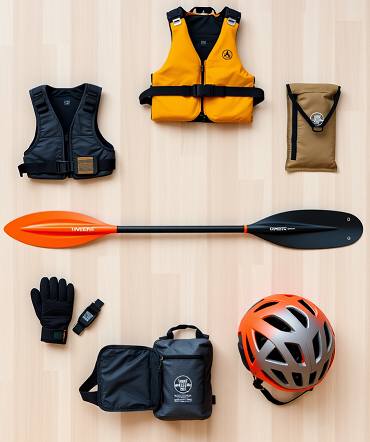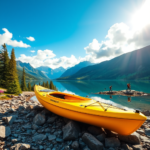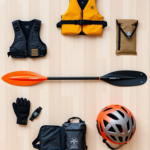Kayaking is an exciting outdoor activity that allows you to connect with nature while getting a great workout. However, for beginners, the thought of venturing out on the water can feel a bit intimidating—especially when it comes to knowing what gear you’ll need. Whether you’re preparing for your first trip or just starting to gather your essentials, this guide will take you through all the essential gear required to get started in kayaking. From the kayak itself to safety equipment and clothing, we’ll cover everything a beginner needs to know.
1. Choosing the Right Kayak
The kayak is obviously the most important piece of gear for any paddling adventure, but choosing the right one depends on where you plan to paddle, your skill level, and your comfort preferences. Here’s a breakdown of the basic types of kayaks:
- Recreational Kayaks: Ideal for beginners, recreational kayaks are designed for calm waters like lakes, slow-moving rivers, and ponds. They are stable, easy to paddle, and comfortable for short outings. These kayaks often have wide, flat hulls, making them great for those who are new to the sport and seeking stability.
- Touring or Sea Kayaks: For those interested in longer trips, touring or sea kayaks are more streamlined and designed for speed and distance. They are typically longer than recreational kayaks and have extra storage for gear.
- Sit-on-Top Kayaks: These are popular for beginners because of their open design, which makes it easier to get in and out. They’re best for warm weather, as you’ll get splashed more often.
- Inflatable Kayaks: If you’re tight on storage space or need something highly portable, inflatable kayaks are a great option. They are surprisingly durable and ideal for casual paddling on calm waters.
When choosing your first kayak, think about where you’ll be kayaking most often and what type of experience you want. For most beginners, a stable, easy-to-maneuver recreational or sit-on-top kayak is a great starting point.
2. Paddle
The paddle is another crucial piece of kayaking gear. Without the right paddle, your kayaking experience can be frustrating, as you may find it difficult to control the kayak. Paddles come in various lengths and materials, so here are some tips for choosing the right one:
- Length: The length of the paddle you need depends on your height and the width of your kayak. A general rule of thumb is that taller paddlers and those with wider kayaks need longer paddles. Most paddles are measured in centimeters, and for recreational kayaks, a paddle length between 210 cm to 240 cm is typical.
- Blade Shape: There are two main types of blades: asymmetrical blades, which are slightly longer on one side and designed for efficient paddling, and symmetrical blades, which are better for casual paddling. Asymmetrical blades tend to be more common for beginners.
- Material: Paddle materials vary, with options such as aluminum, fiberglass, and carbon fiber. Aluminum paddles are more affordable and durable, but they are heavier. Fiberglass and carbon paddles are lighter, which can reduce fatigue on longer trips but tend to be more expensive.
Remember, the lighter the paddle, the easier it is to paddle for extended periods without tiring your arms.
3. Personal Flotation Device (PFD)
Safety should always be a priority when kayaking, and a personal flotation device (PFD), also known as a life jacket, is an essential piece of safety equipment. Even if you’re a strong swimmer, wearing a PFD is non-negotiable. A well-fitting PFD ensures that you stay afloat if you capsize or fall into the water.
- Choosing a PFD: Look for PFDs designed specifically for kayaking. These typically allow for better range of motion in the arms and shoulders, and some even have pockets for storing small gear or snacks. Make sure the PFD fits snugly but comfortably—it should not ride up when you’re seated in the kayak.
- Fit and Comfort: A kayaking PFD should feel snug but not tight, with adjustable straps to ensure it stays in place. It’s essential to try on different sizes and models to find the best fit.
When shopping for a PFD, always check the U.S. Coast Guard certification (or local certification in your country) to ensure it meets safety standards. Never head out on the water without your PFD!
4. Spray Skirt (Optional)
A spray skirt is a waterproof cover that fits snugly around the opening of your kayak and seals around your waist, helping keep water out of the boat. This is particularly useful in rougher waters, cold weather, or when sea kayaking, where waves or splashing water could get into the kayak.
While not necessary for beginners paddling in calm, warm waters, it can become an essential item if you plan on progressing to more challenging conditions or if you want to keep water out on rainy days.
5. Helmet (For White-Water Kayaking)
If you’re venturing into white-water kayaking or plan to paddle in areas with rocks or strong currents, a helmet is an absolute must. A kayaking helmet protects your head from rocks and other hazards you might encounter on rough water or during capsizes.
- Fit: Like PFDs, helmets should fit snugly but comfortably, covering the entire forehead and sitting just above your eyebrows. It should not move around when you shake your head.
- Types: Choose helmets specifically designed for water sports, as they are built to withstand wet conditions and potential impacts. Avoid using bike helmets or other types of helmets that aren’t made for water-based activities.
For beginners who stick to calm lakes or rivers, a helmet may not be necessary, but it becomes crucial for white-water or surf kayaking.
6. Proper Clothing and Footwear
Kayaking clothing can make a big difference in your comfort, especially in cold or unpredictable weather. Here are a few basics:
- Quick-drying clothing: Choose clothing made from synthetic materials like polyester or nylon, which dry quickly and wick moisture away from your body. Cotton should be avoided, as it retains moisture and can make you feel cold.
- Wetsuit or drysuit: If you’re kayaking in cold water, a wetsuit or drysuit can keep you warm and prevent hypothermia. Wetsuits are made from neoprene and trap a thin layer of water between your skin and the suit, which your body heats up. Drysuits, on the other hand, keep water out entirely and are ideal for very cold conditions.
- Water shoes: Proper footwear is essential for kayaking, as you’ll often need to walk in the water or on slippery surfaces. Water shoes or sandals with good grip protect your feet while allowing water to drain out. They should fit securely and not slip off in the water.
7. Dry Bags
Keeping your belongings dry while kayaking is important, especially if you’re bringing items like phones, snacks, or extra clothing. Dry bags are waterproof bags designed to keep your gear dry, even if the bag falls into the water. They come in various sizes, and it’s a good idea to use several smaller bags rather than one large one. That way, you can separate wet and dry gear, as well as important items like electronics.
8. Bilge Pump (For Sit-in Kayaks)
A bilge pump is a small, handheld pump used to remove water from inside your kayak. This is particularly important if you’re using a sit-in kayak, as water can accumulate inside, especially in rough conditions. A bilge pump allows you to quickly remove water and prevent your kayak from becoming too heavy or unstable.
For sit-on-top kayaks, this isn’t necessary, as the water will naturally drain out.
9. Navigation Tools
Depending on where you’re paddling, having navigation tools like a compass, GPS device, or even a map can be essential. For longer trips or paddling in areas where you’re unfamiliar with the surroundings, it’s crucial to have a way to orient yourself and avoid getting lost.
Some kayakers also use a marine radio for communication, especially if venturing into large bodies of water.
10. Safety Whistle and Rescue Gear
Every kayaker should have a safety whistle attached to their PFD in case they need to signal for help. A whistle is an effective way to communicate distress if you’re too far away to yell or if weather conditions make it difficult to be heard.
Additionally, consider having a towline or throw rope on hand in case you or another kayaker needs assistance. This gear can be used to help rescue a capsized kayaker or tow someone back to shore if needed.
Conclusion
Kayaking can be an incredible experience, but having the right gear is essential for safety and enjoyment. By investing in high-quality equipment, such as the right kayak, paddle, and safety gear, beginners can ensure a smooth introduction to the sport. Over time, you’ll likely add more specialized gear to your kit, but the essentials listed above will help you start your kayaking journey on the right foot.




